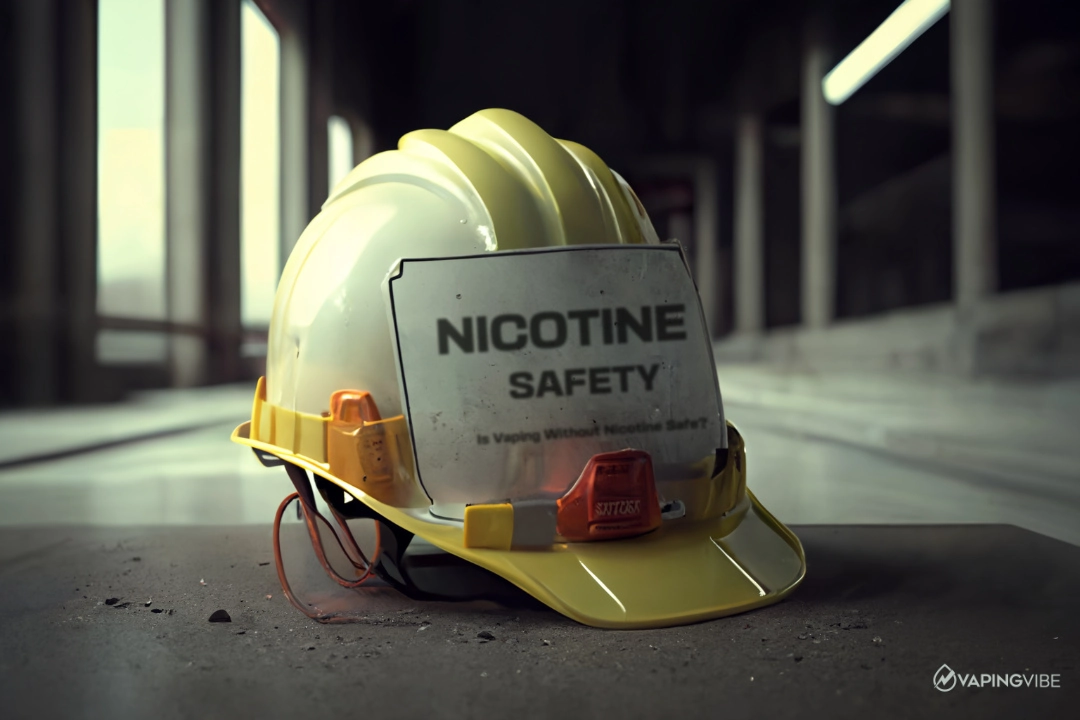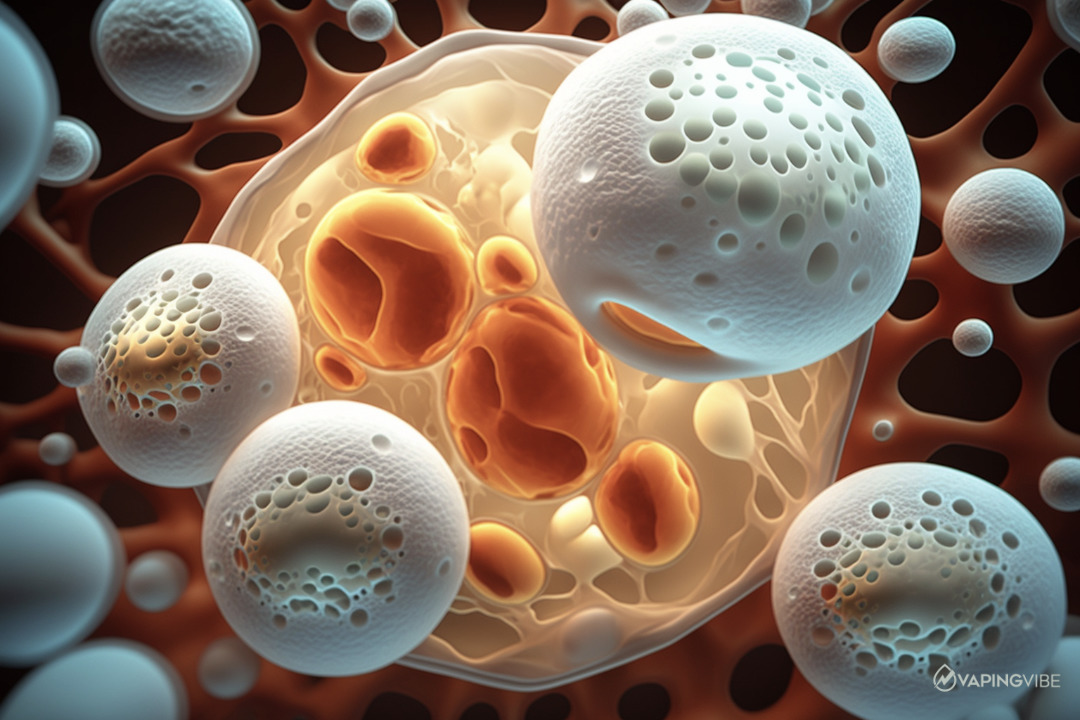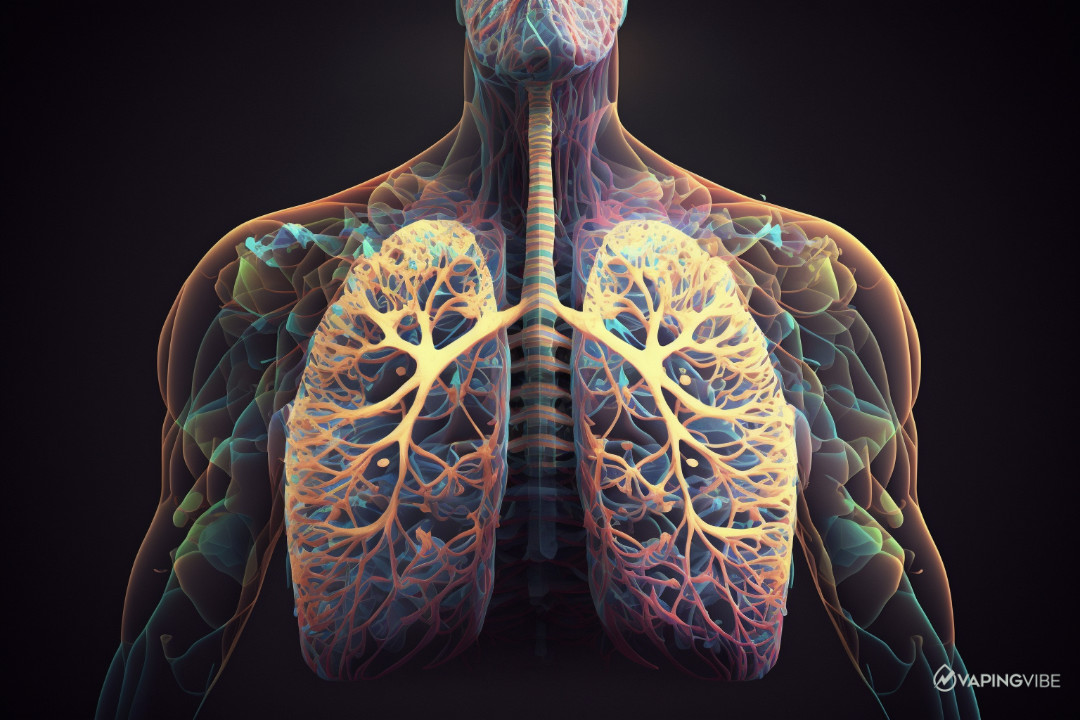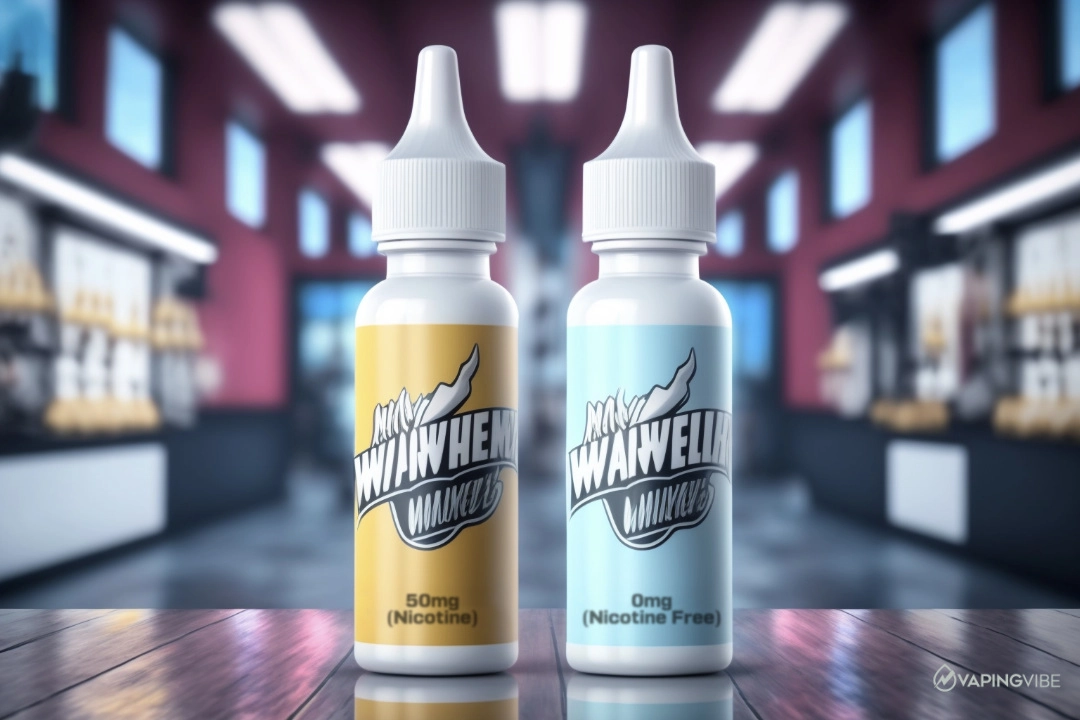QUICK LINKS
- Is Vaping Without Nicotine Harmful?
- Is Vaping Without Nicotine Safe?
- Irritation
- Toxicity
- Inflammatory and Oxidative Responses
- How Harmful Are Non-Nicotine Vapes?
- Is Vaping Without Nicotine Safe for Lungs?
- Does Nicotine-Free Vaping Raise Blood Pressure?
- Is Nicotine-Free Vape Juice Better Than Juice That Contains Nicotine?
- Is Vaping Nicotine Better Than Smoking Cigarettes?
- What About CBD Vapes?
- Wrapping Up
Is Vaping Without Nicotine Harmful?
For a long time, the concept of vaping has been inextricably linked to nicotine. When we say e-cigarette, we think about throat hits, nicotine strengths, and the satisfying feeling of getting a nicotine fix.
In recent years, a new wave of nicotine-free vapers has emerged. New e-cigarettes are manufactured with nicotine-free vape juice, and millions of people are reaping the benefits. Now, lots of people use either use low-nicotine or nicotine-free vapes.
The general idea is that nicotine-free vapes tackle an individual’s nicotine addiction whilst still providing them with the familiar, comforting feeling of using an e-cigarette. The toxic volatile organic chemicals are eliminated, and vapers can enjoy their favorite vape juice without the harmful chemicals.
Unfortunately, nicotine-free e-cigs are not without problems.

Is Vaping Without Nicotine Safe?
Smoking cigarettes is a thing of the past; individuals are being urged to quit nicotine and switch to a safer alternative. 0% nicotine e-juice is thought to be the safest alternative out there, but just how true is this claim?
This relatively new area of interest is crying out for more research, but until then we’ll tell you what we know.
Irritation
When the question ‘are nicotine-free vapes safe?’ arises, we go back to the basics. All e-liquid contains VG (vegetable glycerin) and PG (propylene glycol). These two materials form the basis for every liquid, whether it contains nicotine or not.
Both VG and PG are common additives that you might find in toothpaste, gel, or even canned food as a preservative. PG is colorless, odorless, and has a faintly sweet taste. It is used as a solvent, preservative, moisture preserver, and emulsifier. In vape juice, PG creates unforgettable throat hits and carries flavoring chemicals much better than VG.
Unfortunately, it is not uncommon to have an allergic reaction to PG. Dermatologists have found that PG allergy rates increase from an average of 0.8% – 3.5% to 10% – 30% when it is in an aqueous solution, meaning lots of new vapers discover that they are sensitive to PG.
Let’s take a look at the main symptoms of a PG allergy.
- Sore throat
- Swollen gums
- Skin irritation
- Sinus issues
- Headaches
It’s important to note that ex-smokers also experience these symptoms when they stop smoking cigarettes. Cigarette smoking can cause a wide range of problems, and it doesn’t stop there. As soon as an individual starts vaping nicotine instead of smoking it, they will enter a transition period. These unpleasant side effects are just some of the things that they could experience. Of course, if they decide to use a non-nicotine vape juice and quit the stuff entirely, their symptoms will be much worse. Nicotine withdrawal is no joke, especially for people who have been smoking for decades.
Toxicity
Studies have found that nicotine-free vape liquid can have a toxic effect on human cells. In-vitro discovered that flavoring chemicals in e-liquids can impact the blood vessels in the heart. When blood vessel cells die, the individual is at a greater risk of vascular problems, which often lead to heart disease, diabetes, and high blood pressure.

Inflammatory and Oxidative Responses
Nicotine-free vapes might be seen as a safe alternative, but it still has problems. Flavored e-liquids can trigger the cells in the immune system. The vapor becomes condensation on the human alveolar macrophages, in other words, the vapor inflames lung tissues. It can also have adverse effects on throat tissues, which most vapers will have experienced.
Another school of thought argues that nicotine-free vape juice creates inflammation in specific types of white blood cells. White blood cells are part of the immune system, and they are responsible for fighting infection and other harmful diseases. When these cells are compromised, the individual is more susceptible to common colds and other illnesses.
How Harmful Are Non-Nicotine Vapes?
So, are nicotine-free vapes safe?
As we have discovered, nicotine-free vapes are not entirely safe. If you vape without nicotine, you still have to be aware of the potential harmful effects.
E-cigarette smoking is not without its risks, but you can be a conscientious consumer by regularly checking in with yourself. Some of the questions that you might want to ask yourself include:
- Do I have a persistent cough? Have I had it for more than a few weeks?
- Does my throat feel constantly inflamed?
- Am I experiencing any new aches and pains?
Another good idea is regular physical checkups. The benefits of checkups can’t be overstated, especially for people who have been consuming e-liquid for years.

Is Vaping Without Nicotine Safe for Lungs?
Have you ever noticed that nicotine sensation tickling your throat? How about your lungs? It is not uncommon for new vapers to notice a difference in their mouth, throat, and lungs. This is because the chemicals in nicotine irritate (or ‘tickle’) the cells in every area that they touch.
If nicotine is the problem, nicotine-free vape juice must be the answer. Right?
Wrong. Eliminating nicotine entirely does greatly reduce the health risks associated with vaping products, but you might still experience irritation, discomfort, and even diseases.
We’ve already explored the possibility that e-liquid flavoring chemicals harm vessels in the heart, but there is one more unfortunate side effect.
One in-vitro study discovered that vape liquid vapor caused cell death, even with nicotine-free e-cigarette juice. The cells are located in the lungs, and they protect the human body from all sorts of harmful bacteria and particles. When these cells die, the lungs can’t defend themselves against all the toxins in the air. As a result, pulmonary diseases are far more common.
Of course, this is just one study. We will only understand the impact of nicotine-free vaping products far into the future. It is still far safer to inhale nicotine-free liquid than a traditional cigarette. If you’re still not convinced, check out our Top 9 Reasons to Vape Without Nicotine.

Does Nicotine-Free Vaping Raise Blood Pressure?
When people ask, ‘is vaping without nicotine safe?’ they often forget about blood pressure.
Blood pressure is a measure of the force that your heart uses to pump blood around your body. The higher the blood pressure, the harder your heart and arteries have to work. If an individual has high blood pressure for a long time, their arteries will become less elastic, which lessens the flow of blood to the heart. As a result, heart disease is far more likely.
A 2018 study that documented the effect of electronic cigarette smoking on blood pressure in hypertensive patients found that e-cigs were ‘accompanied by significant increase [in] blood pressure, which lasted about 30 minutes.’
Researchers were quick to conduct similar studies, this time for nicotine-free vaping. Felix W Wehrli led a study on 31 non-smokers and new vapers between the ages of 18 and 35. The participants took 16 three-second puffs and were found to have worse circulation, stiffer arteries, and less oxygen in their blood. Felix and his team found that nicotine-free vaping, which is often marketed as a healthier alternative to nicotine vape juice, causes high blood pressure and other issues.

Is Nicotine-Free Vape Juice Better Than Juice That Contains Nicotine?
You might be wondering, what’s the point in switching to nicotine-free vape liquid? It is generally accepted that vaping without nicotine has fewer health risks, and you don’t even have to settle for a boring kit. Some of the Best Non Nicotine Vape Kits have come out in the last year or so, which shows that manufacturers are responding to the massive customer demand for lower-nicotine products.
The long-term impact of nicotine-free e-cigarettes (think 30 – 40 years) is not apparent, so the chances are that we will be waiting a long time to discover the effects of nicotine-free vape liquids. All we can do is make some assumptions based on our findings so far.
We know that nicotine has a detrimental impact on human health, so it follows that nicotine-free vape options are far better.
This raises the question, is vaping nicotine better than smoking cigarettes?

Is Vaping Nicotine Better Than Smoking Cigarettes?
Electronic nicotine delivery systems (better known as e-cigarettes to you and me) are far less damaging than cigarettes.
Your e-cigarette might feel more satisfying when it contains high-nicotine e-liquid, but it is also more dangerous. Take all the potential harmful health effects associated with nicotine-free vape liquids, and add all the harmful effects of nicotine on top.
Nicotine is derived from the tobacco plant. Tobacco cigarettes contain more than 7,000 chemicals, most of which are toxic to humans. The term toxic is often misunderstood as something that causes an immediate and sudden reaction. In fact, tobacco toxicity is a slow process.
By smoking tobacco, you are inhaling toxic chemicals into your blood vessels and lung tissues. There are 7,000 chemicals to choose from, so there is no shortage of attacks on your system. The chemicals impact white blood cells, blood vessels in the heart, the lymphatic system, and more.
The Centers for Disease Control and Prevention (CDC) found that smoking cigarettes is responsible for more than 480,000 deaths every year. The nicotine that goes into e-liquids typically contains far fewer toxins.
Even better, e-cigarettes do not produce carbon monoxide or tar. This eliminates some of the biggest health risks associated with smoking cigarettes. Tar is a chemical substance and byproduct of tobacco when it is burned. When an individual takes a drag on a cigarette, the tar forms a tacky brown or yellow substance that sticks to lung tissue. This leads to lung issues like cancer or emphysema. The CDC found that smoking cigarettes causes around 90% of all lung cancer deaths and 80% of all deaths from chronic pulmonary disease (COPD).
In short, switching from cigarettes to e-cigarettes is one of the best things that you can do for your health. Nicotine vapes do still contain harmful and addictive chemical compounds, but they are nowhere near as dangerous as tobacco cigarettes.

What About CBD Vapes?
Cannabidiol (marketed as CBD) is derived from the hemp plant. CBD vape liquid contains cannabidiol instead of nicotine. Lots of people consume CBD in vape liquid, even though there has been some debate over the best way to ingest it.
CBD has many benefits, including an almost immediate feeling of calm and relaxation. Too much CBD can lead to drowsiness or lethargy, so it is important to find the right concentration. CBD also has anti-inflammatory properties, meaning it can help with chronic pain.
The question of whether or not CBD vape juice is safe is up for debate. Like any substance, CBD has some negative side effects, which include:
- Drowsiness
- Decreased appetite
- Dry mouth
- Diarrhea
- Nausea
- Sickness
- Stomach discomfort
- Irritability
- Vomiting
One of the main problems with CBD juice is that there is very little regulation. In 2018, the Farm Bill eliminated CBD from the definition of marijuana in the Controlled Substances Act, but CBD is still subject to the scrutiny of the FDA, just like nicotine.
That being said, there is very little other regulatory oversight into CBD. Certification is a problem, especially when it comes to labeling products. It is not uncommon for CBD products to be mislabeled, meaning individuals may mistakenly consume a toxic substance or something they are allergic to.
To explore the extent of this problem, the Associated Press (AP) commissioned a study to analyze nearly 30 oils that were labeled as CBD. They found that 10 of the 30 vapes contained synthetic marijuana, eight of the oils had no level of CBD, and 14 oils contained less than 0.3% of CBD by weight.
CBD brands might claim to offer a healthier alternative to nicotine, but you should always be wary of the potential problems that come with a relatively new, unregulated substance.
Wrapping Up
No one can deny that electronic cigarettes are far less harmful when they don’t contain nicotine. Switching from smoking cigarettes to using vape pens is a push in the right direction, but switching to nicotine-free liquid is even better.
E-cigarette flavoring chemicals can still be harmful to human health, but they are nowhere near as harmful as nicotine. Nicotine-free vapes and nicotine vapes share a lot of the same health risks but to different extents. Whether you are smoking a 0% nicotine liquid or a 20% nicotine liquid, you need to be aware of the implications for your pulmonary and respiratory health.

